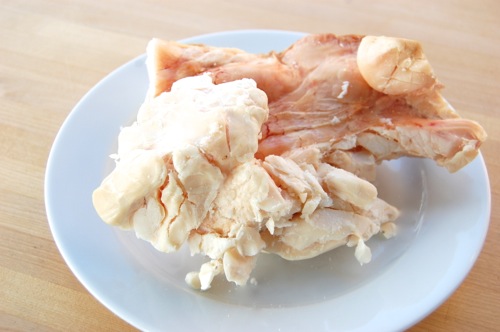Suet

Suet is beef fat, though not just any beef fat. It’s taken from the kidney region of the steer, so in that way it’s analogous to leaf lard from a pig (normal subcutaneous beef fat is simply known as “tallow”). What’s special about suet is that it’s mild tasting and extremely firm, in fact it’s the hardest of all the fats humans commonly eat. Whoever can tell me what it is that makes suet the firmest of the fats gets a A for this course. Anyone? Anyone? Yes you at the back with the heart condition. That’s right: it’s the highest in saturated fats. Saturation = firmness, that’s rule of fat.
It’s that very firmness that makes suet valuable in the pastry kitchen, notably in the realm of English puddings. Being so rich in saturated triglycerides it has a very broad melting point, also a very high one, about 120 degrees Fahrenheit. That helps create a more open crumb and lighter texture in a pudding, as the starch and egg proteins around the suet shreds has time to gelate and firm before the fat melts entirely. That creates lots and lots of little holes, which keep the pudding from settling into a brick, as many traditional puddings contain no leavening.
What, no schmaltz?
I haven’t finished yet! 😉
Joe, So pleased to see you featuring suet. Such a great fat. Let’s hope it becomes available in the markets. Nothing like it for feather light steamed chocolate, lemon, marmalade, apple, and beef puddings.
Funny, but it’s fairly easy to find at butcher shops around here. A lot easier to find than leaf lard!
– Joe
I have to admit you surprised me with this one! I have used suet many times in cooking but never in baking.
Now I am going to have to run around & find some recipes!
It’s a mostly overlooked fat, I think. And amazingly inexpensive. Most people buy to feed birds!
– Joe
Haha, I was actually going to comment why my boyfriend had to wake up early in his vacation and go to market for suet in the very morning – because it’s bought by people who feed birds in winter, therefore disappears from shelf very quickly!
Actually now I see that what he bought might actually be leaf lard, because pork and its by-products is far more popular here. But anyway, mincemeat (for which we needed suet) turned out great, no matter which fat was put in it. Thank you for this great topic of fats, it’s really interesting and useful!
I always having fun blogging on topics like this, Antuanete! Thanks!
– Joe
These posts on fats are opening up a whole new world to me! Thank you.
Wow, Melody, great to hear! Thanks very much for the comment…I ain’t done yet! 😉
– Joe
Does suet need to be rendered like leaf lard, or do you use it straight out of the cow?
You can do either, however most of the time it’s simply shredded and stirred right into a pudding batter or batch of mincemeat.
– Joe
The cracklings left from rendering beef fat are as delicious as those from rendered lard, but if you feel you shouldn’t eat *all* of them, freeze them for the next time you need to make beef stock. They add a great deal of flavor!
Hey Sally!
Schmaltz crackings (gribenes) are excellent too. Hard to see where you can really go wrong with any of these! 😉
– JOe
you should totally make galletitas de grasa, Argentinian biscuits made with beef fat.
actually, much of commercial Argentinian baked goods feature beef fat as their fatty ingredient, possibly because of its properties but probably because it is widely-available and I suspect very cheap there, on account of all the beef industry.
anyway, the galletitas or bizcochitos de grasa are salty and crispy and they melt in your mouth in beautiful layers. please make some.
I’ll see if I can find a recipe, Ana. Good suggestion!
– Joe
Thanks for these posts Joe! My cooking instructor was using shortening to make biscuits and I got all curious and wanted to know what the difference was between shortening, lard and tallow. Now I know. (Shortening is vegetable fat, lard is pork fat and tallow/suet is beef fat.) Schmaltz was completely new for me. Thanks for the info!
Very happy to help, Lisa! And thanks for the comment.
– Joe
We’ve just got to have beef suet for Christmas to roast the potatoes and onions that accompany the beef… (It’s a holiday. We all know that holiday food has no calories or cholesterol, right?)
Down here it’s virtually impossible to find a rib roast of beef that hasn’t had ALL the fat trimmed off, so this makes me nuts. After searching on Google I found this place (please forgive the ugly link, but I’m a bit of a Luddite):
http://www.grasslandbeef.com/Detail.bok?no=670
So I’ll be ready for next year…